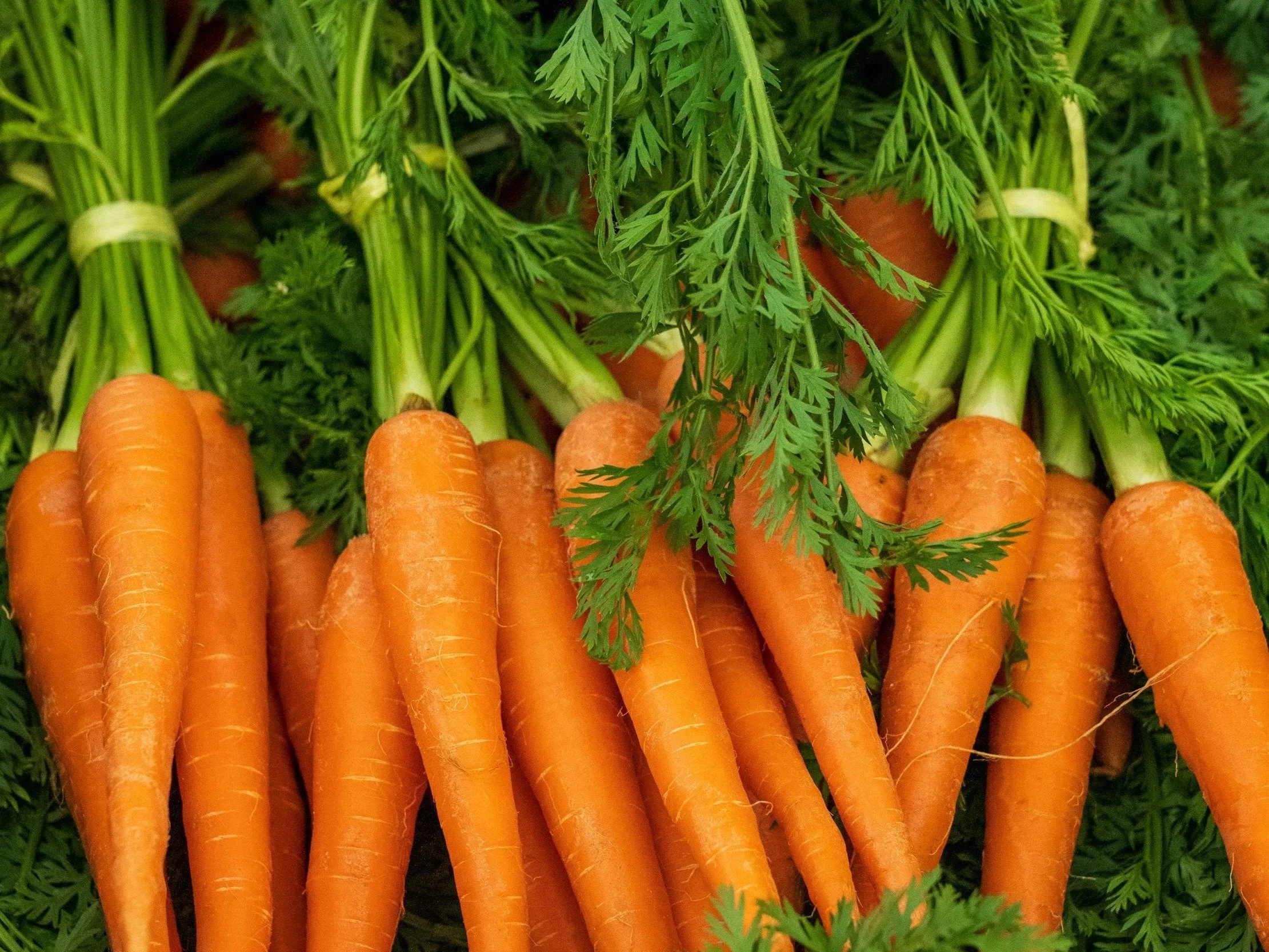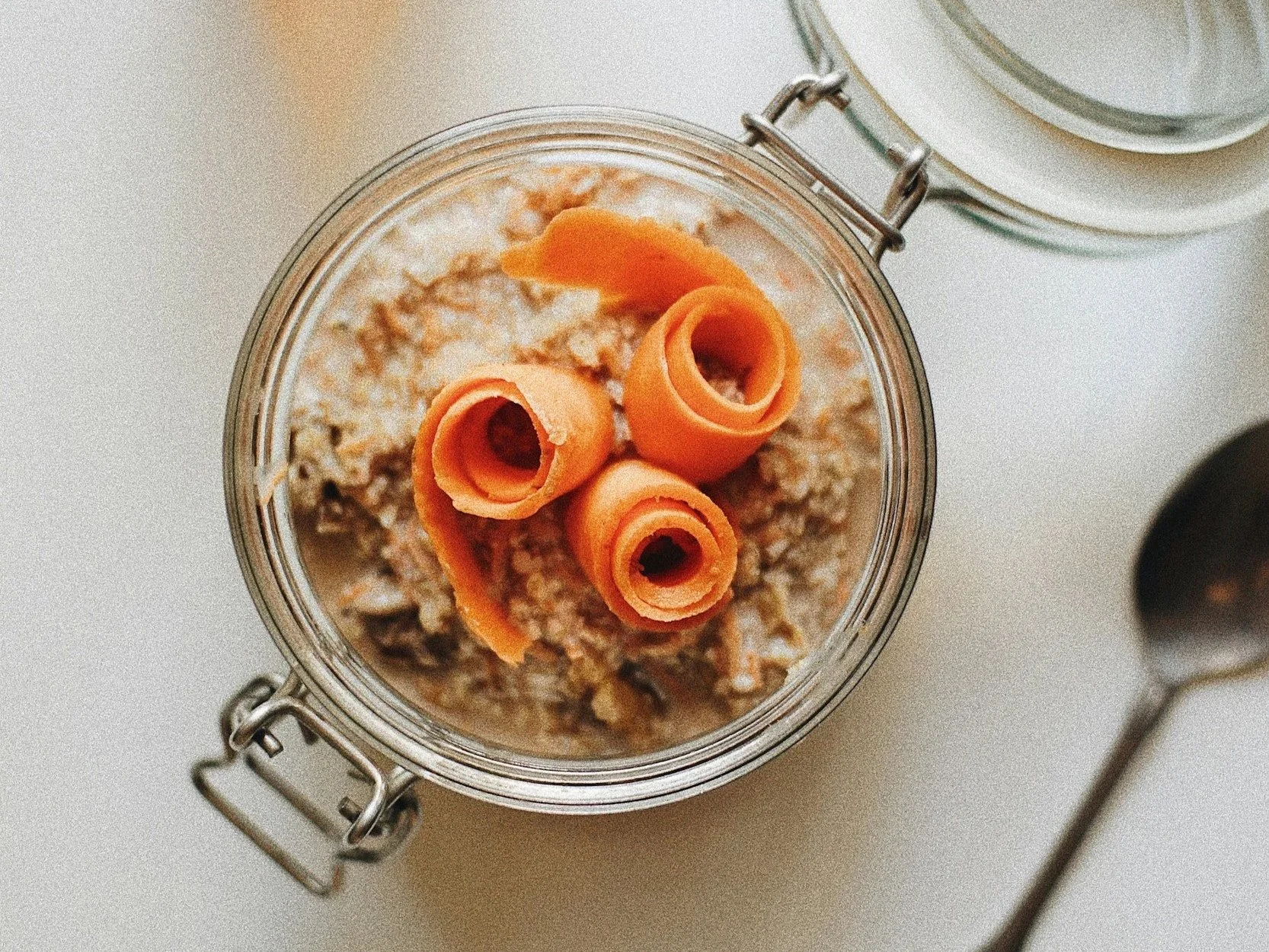That carrot glow
Scroll to the bottom for a delicious
baked carrot oatmeal recipe.
by Jill Aida Horn, MPH
Sometimes the most ordinary foods are the most extraordinary for our health. Carrots, long associated with eye health, are now recognized for much more: improving skin glow, supporting gut health through fiber and polyphenols, and even contributing to cognitive resilience. Inexpensive, versatile, and deeply nourishing, they prove that wellness often starts with what’s already on our plate.
1. For Eyes, Skin, and Radiant Color
The bright orange color of carrots comes from beta-carotene, which your body converts into vitamin A. Vitamin A supports your eyesight, boosts immunity, and contributes to smooth, glowing skin. Studies have even shown that carotenoids influence how radiant and healthy your skin looks [1,2]. Just one medium carrot gives you more than double your daily vitamin A. Intervention studies also show that increased carotenoid consumption reduces UV-induced erythema (sunburn sensitivity) and supports skin photoprotection [3,4].
2. Polyphenols and the Gut Microbiome
While carotenoids get most of the spotlight, carrots are also rich in polyphenols—plant compounds with powerful effects on the gut. Polyphenols not only act directly as anti-inflammatory agents, but also serve as fuel for beneficial gut bacteria [5]. When these microbes metabolize polyphenols, they produce bioactive metabolites that improve intestinal health, regulate immune responses, and may even influence mood and brain health [6]. This crosstalk between carrots, polyphenols, and the microbiome underscores why “you are what you eat” has deep scientific truth.
3. Fiber for Your Gut (and Mood)
Carrots also provide both soluble and insoluble fiber, creating a two-pronged benefit: soluble fiber helps stabilize blood sugar and cholesterol, while insoluble fiber keeps digestion running smoothly. Together, they feed the microbiome, improve gut barrier function, and lower systemic inflammation [7,8]. With most Americans falling short on fiber intake, a daily carrot habit is an easy way to bridge the gap.
4. Brain and Mood Benefits
Carrots also provide both soluble and insoluble fiber, creating a two-pronged benefit: soluble fiber helps stabilize blood sugar and cholesterol, while insoluble fiber keeps digestion running smoothly. Together, they feed the microbiome, improve gut barrier function, and lower systemic inflammation [7,8]. With most Americans falling short on fiber intake, a daily carrot habit is an easy way to bridge the gap.
Final Bite: Carrots prove that everyday foods can have extraordinary power. From boosting skin glow to nurturing your microbiome and protecting long-term brain and body health, they’re a small, simple choice with wide-reaching impact. Whether raw, roasted, or baked into cozy oatmeal, carrots help you glow from the inside out.
Recipe of the Week:
Carrot Cake Baked Oatmeal:
warming, spiced, and nutrient-dense
Ingredients:
Dry mixture
2 cups old-fashioned rolled oats (gluten free if needed)
1 tsp baking powder
1/4 tsp ground ginger
1/4 tsp ground nutmeg
1/2 tsp ground cinnamon
1/4 tsp ground cardamom
1/4 tsp ground vanilla or 1/2 tsp vanilla extract
Pinch of coarse sea salt
1 1/3 cups (200 g) grated raw carrot (about 4 carrots)
A handful of raisins
Wet mixture
2 organic eggs or chia seed mixture (see note)
2 1/4 cups (500 ml) plant milk of your choice
Crunchy top layer
4 tbsp maple syrup, honey, or apple syrup
2 tbsp coconut oil (plus extra for greasing the pan)
1 cup (180 g) walnuts or other nuts of choice
3/4 cup (100 g) sunflower seeds or seeds of choice
Directions:
Preheat oven to 375°F (180°C). Grease an 8 x 10 inch (20 x 25 cm) baking dish with coconut oil.
In a mixing bowl, combine oats, baking powder, spices, salt, grated carrots, and raisins.
In a separate bowl, whisk eggs (or chia mixture) with plant milk.
For the crunchy topping, combine sweetener, coconut oil, nuts, and seeds until coated.
Spread oat mixture into the baking dish, pour over wet mixture, and stir lightly to soak.
Sprinkle topping evenly. Bake 25–35 minutes, until set and golden.
Cool slightly before serving.
This article was constructed based on peer-reviewed scientific literature. References used:
Stephen, I. D., et al. (2011). Evolution and Human Behavior, 32(3), 216–227.
Whitehead, R. D., et al. (2012). Evolution and Human Behavior, 33(6), 457–463.
Heinrich, U., et al. (2003). Journal of Nutrition, 133(1), 98–101.
Stahl, W., & Sies, H. (2012). American Journal of Clinical Nutrition, 96(5), 1179S–1184S.
Cardona, F., et al. (2013). Journal of Nutritional Biochemistry, 24(8), 1415–1422.
Selma, M. V., et al. (2009). Journal of Agricultural and Food Chemistry, 57(15), 6485–6501.
Holscher, H. D. (2017). Gut Microbes, 8(2), 172–184.
Tucker, K. L. (2014). American Journal of Clinical Nutrition, 99(5), 1220S–1225S.
Johnson, E. J. (2012). Nutrients, 4(9), 1182–1205.


